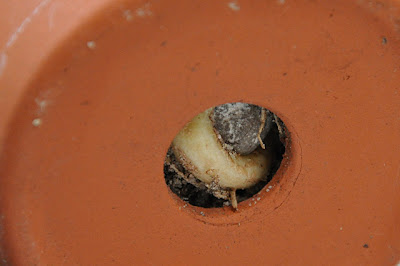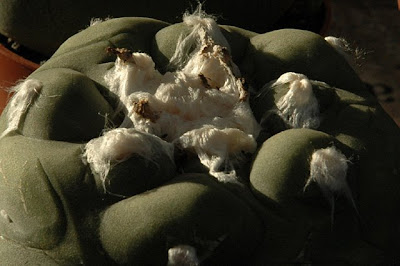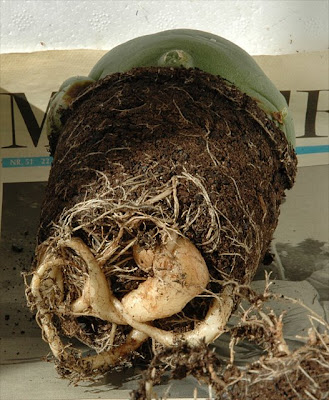Since 2004 I have experimented with growing Lophophora williamsii in an unheated greenhouse in Denmark. During this period the plants have been repotted only once a couple of years ago.
Coldhouse grown Lophophora williamsii (SB 854; Starr Co, Texas)
The plants are growing in 11 cm (4.33'') clay pots and it might not be apparent from a superficial inspection that they are in need of being repotted again. But on closer investigation it turns out that the taproots are visible through the drainage hole in the bottom of the pots.
Taproot visible through drainage hole
I consequently decided to repot the plants. I'm usually not repotting plants in the coldhouse this early in the year as we still might get the occasional night with sub-freezing temperatures, but I figured that the plants are completely dormant – i.e. there are no actively growing roots to harm – and if repotted in bone-dry soil the plants will not notice they have been disturbed when the growing season starts in a few weeks. Anyway, that's my theory ;-)
Lophophora williamsii plants removed from the pots
Close-up of three Lophophora williamsii crowns
Close-up of exposed Lophophora williamsii taproot-ball
After removing the plants from their pots I could smell that some of the roots had been damaged; a broken Lophophora root gives off an easily detectable smell reminiscent (to me anyway ;-) of that of fresh green peas. This stressed the fact that the soil really had to be bone-dry before potting the plants, so I let them sit for a day in order for the broken roots to dry out a bit, and shoved the soil into the oven to remove every last bit of moisture it might hold (this gave off an... let's call it interesting... smell and I weren't popular at all with the rest of the house).
The soil ended up being so dry that I was literally working in a cloud of dust while repotting – my throat was still irritated the day after so I'll probably buy a dust mask to avoid this situation in the future (not that I expect to get pneumoconiosis or anything but it's annoying to go “ahem”, “hrmph”, “cough” for a day when it can be avoided ;-).
Freshly repotted Lophophora williamsii plants
The dry and dusty soil is also evident by the dusted fingerprints on the pots (12 x 12 x 20 cm, ideal for plants with large taproots) in the picture above.
Lastly I would like to make a note on the soil. I am adding unperfumed (and unused ;-) cat litter made from baked “moler” to my soil as this material is very lightweight and retains water easily without the soil getting soaked. I'm not quite sure how to translate “moler” into English but it is a diatomite deposit that Skamol, a “moler” processing plant, defines as:
Moler - a diatomaceous earth
Diatomaceous earth is a naturally occurring, soft, chalk-like sedimentary rock that is easily crumbled into a fine white to off-white powder. This powder has an abrasive feel, similar to pumice powder, and is very light, due to its high porosity. Moler is a special mixture of diatomaceous earth and bentonite clay, ca. 60% diatoms and 40% clay. The clay gives the raw moler a brownish colour, and due to a high iron oxide content the materials become pink, when baked.
The pinkish granules visible in the topsoil in the photo above is “moler” cat litter.
As I live within driving distance of where the “moler” is quarried I decided to get some raw and unbaked “moler” to mix into my soil. Last summer I collected a few bags in the, now defunct, quarry pictured below; the plants described in this post are the first to be planted in soil with chunks of raw “moler” mixed in (visible as large, grayish flakes in the above picture), so I'm eager to see how the plants agree with this new additive to their soil. Even though “moler” contains large fractions of clay (the Danish word “ler” means clay, i.e. a literal translation of “moler” would be mo-clay) it's a relatively stable material that doesn't dissolve in water, so it will not clog up the soil when watered.

Old moler quarry on the island of Mors
I'm a bit curious as to what effect diatomaceous earth has on insects. According to Wikipedia “diatomite is also used as an insecticide, due to its physico-sorptive properties. The fine powder absorbs lipids from the waxy outer layer of insects' exoskeletons, causing them to dehydrate”, i.e. the diatomaceous earth in the “moler” might actively help me control pests.






















